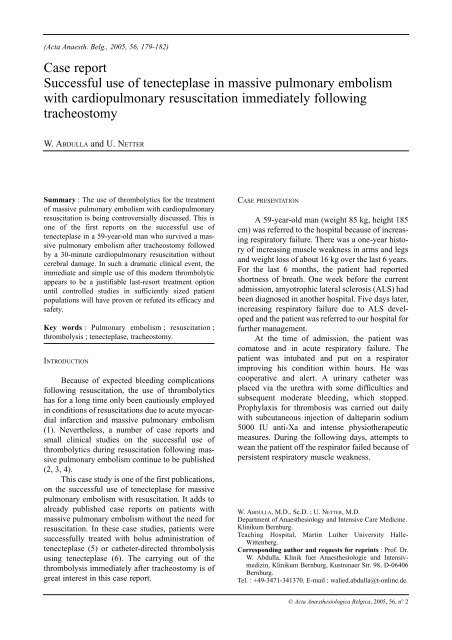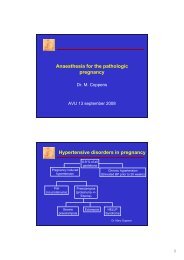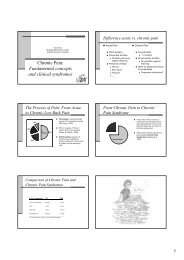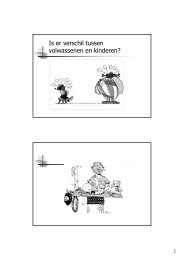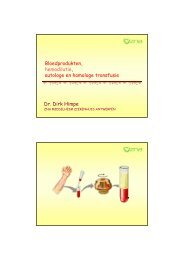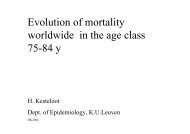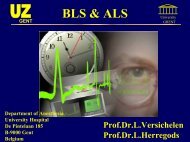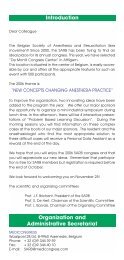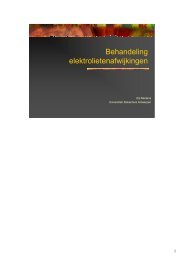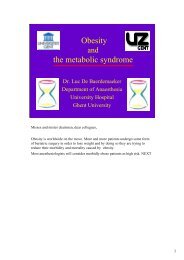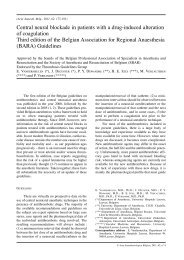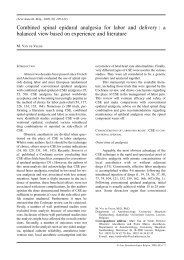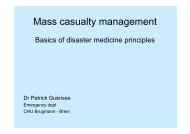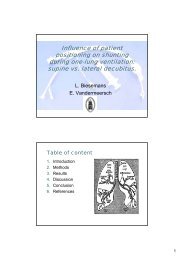Case report Successful use of tenecteplase in massive pulmonary ...
Case report Successful use of tenecteplase in massive pulmonary ...
Case report Successful use of tenecteplase in massive pulmonary ...
Create successful ePaper yourself
Turn your PDF publications into a flip-book with our unique Google optimized e-Paper software.
(Acta Anaesth. Belg., 2005, 56, 179-182)<br />
<strong>Case</strong> <strong>report</strong><br />
<strong>Successful</strong> <strong>use</strong> <strong>of</strong> <strong>tenecteplase</strong> <strong>in</strong> <strong>massive</strong> <strong>pulmonary</strong> embolism<br />
with cardio<strong>pulmonary</strong> resuscitation immediately follow<strong>in</strong>g<br />
tracheostomy<br />
W. ABDULLA and U. NETTER<br />
Summary : The <strong>use</strong> <strong>of</strong> thrombolytics for the treatment<br />
<strong>of</strong> <strong>massive</strong> <strong>pulmonary</strong> embolism with cardio<strong>pulmonary</strong><br />
resuscitation is be<strong>in</strong>g controversially discussed. This is<br />
one <strong>of</strong> the first <strong>report</strong>s on the successful <strong>use</strong> <strong>of</strong><br />
<strong>tenecteplase</strong> <strong>in</strong> a 59-year-old man who survived a <strong>massive</strong><br />
<strong>pulmonary</strong> embolism after tracheostomy followed<br />
by a 30-m<strong>in</strong>ute cardio<strong>pulmonary</strong> resuscitation without<br />
cerebral damage. In such a dramatic cl<strong>in</strong>ical event, the<br />
immediate and simple <strong>use</strong> <strong>of</strong> this modern thrombolytic<br />
appears to be a justifiable last-resort treatment option<br />
until controlled studies <strong>in</strong> sufficiently sized patient<br />
populations will have proven or refuted its efficacy and<br />
safety.<br />
Key words : Pulmonary embolism ; resuscitation ;<br />
thrombolysis ; <strong>tenecteplase</strong>, tracheostomy.<br />
INTRODUCTION<br />
Beca<strong>use</strong> <strong>of</strong> expected bleed<strong>in</strong>g complications<br />
follow<strong>in</strong>g resuscitation, the <strong>use</strong> <strong>of</strong> thrombolytics<br />
has for a long time only been cautiously employed<br />
<strong>in</strong> conditions <strong>of</strong> resuscitations due to acute myocardial<br />
<strong>in</strong>farction and <strong>massive</strong> <strong>pulmonary</strong> embolism<br />
(1). Nevertheless, a number <strong>of</strong> case <strong>report</strong>s and<br />
small cl<strong>in</strong>ical studies on the successful <strong>use</strong> <strong>of</strong><br />
thrombolytics dur<strong>in</strong>g resuscitation follow<strong>in</strong>g <strong>massive</strong><br />
<strong>pulmonary</strong> embolism cont<strong>in</strong>ue to be published<br />
(2, 3, 4).<br />
This case study is one <strong>of</strong> the first publications,<br />
on the successful <strong>use</strong> <strong>of</strong> <strong>tenecteplase</strong> for <strong>massive</strong><br />
<strong>pulmonary</strong> embolism with resuscitation. It adds to<br />
already published case <strong>report</strong>s on patients with<br />
<strong>massive</strong> <strong>pulmonary</strong> embolism without the need for<br />
resuscitation. In these case studies, patients were<br />
successfully treated with bolus adm<strong>in</strong>istration <strong>of</strong><br />
<strong>tenecteplase</strong> (5) or catheter-directed thrombolysis<br />
us<strong>in</strong>g <strong>tenecteplase</strong> (6). The carry<strong>in</strong>g out <strong>of</strong> the<br />
thrombolysis immediately after tracheostomy is <strong>of</strong><br />
great <strong>in</strong>terest <strong>in</strong> this case <strong>report</strong>.<br />
CASE PRESENTATION<br />
A 59-year-old man (weight 85 kg, height 185<br />
cm) was referred to the hospital beca<strong>use</strong> <strong>of</strong> <strong>in</strong>creas<strong>in</strong>g<br />
respiratory failure. There was a one-year history<br />
<strong>of</strong> <strong>in</strong>creas<strong>in</strong>g muscle weakness <strong>in</strong> arms and legs<br />
and weight loss <strong>of</strong> about 16 kg over the last 6 years.<br />
For the last 6 months, the patient had <strong>report</strong>ed<br />
shortness <strong>of</strong> breath. One week before the current<br />
admission, amyotrophic lateral sclerosis (ALS) had<br />
been diagnosed <strong>in</strong> another hospital. Five days later,<br />
<strong>in</strong>creas<strong>in</strong>g respiratory failure due to ALS developed<br />
and the patient was referred to our hospital for<br />
further management.<br />
At the time <strong>of</strong> admission, the patient was<br />
comatose and <strong>in</strong> acute respiratory failure. The<br />
patient was <strong>in</strong>tubated and put on a respirator<br />
improv<strong>in</strong>g his condition with<strong>in</strong> hours. He was<br />
cooperative and alert. A ur<strong>in</strong>ary catheter was<br />
placed via the urethra with some difficulties and<br />
subsequent moderate bleed<strong>in</strong>g, which stopped.<br />
Prophylaxis for thrombosis was carried out daily<br />
with subcutaneous <strong>in</strong>jection <strong>of</strong> daltepar<strong>in</strong> sodium<br />
5000 IU anti-Xa and <strong>in</strong>tense physiotherapeutic<br />
measures. Dur<strong>in</strong>g the follow<strong>in</strong>g days, attempts to<br />
wean the patient <strong>of</strong>f the respirator failed beca<strong>use</strong> <strong>of</strong><br />
persistent respiratory muscle weakness.<br />
W. ABDULLA, M.D., Sc.D. ; U. NETTER, M.D.<br />
Department <strong>of</strong> Anaesthesiology and Intensive Care Medic<strong>in</strong>e.<br />
Kl<strong>in</strong>ikum Bernburg.<br />
Teach<strong>in</strong>g Hospital, Mart<strong>in</strong> Luther University Halle-<br />
Wittenberg.<br />
Correspond<strong>in</strong>g author and requests for repr<strong>in</strong>ts : Pr<strong>of</strong>. Dr.<br />
W. Abdulla, Kl<strong>in</strong>ik fuer Anaesthesiologie und Intensivmediz<strong>in</strong>,<br />
Kl<strong>in</strong>ikum Bernburg, Kustrenaer Str. 98, D-06406<br />
Bernburg.<br />
Tel. : +49-3471-341370. E-mail : walied.abdulla@t-onl<strong>in</strong>e.de.<br />
© Acta Anæsthesiologica Belgica, 2005, 56, n° 2
180 W. ABDULLA AND U. NETTER<br />
A percutaneous tracheostomy (Ciaglia Blue-<br />
Rh<strong>in</strong>o® Set EZ Pass® Hydrophilic Coat<strong>in</strong>g,<br />
William Cook Europe, DK-4632 Bjaeverskov,<br />
www.cookgroup.com) was performed 12 days after<br />
referral. An x-ray taken 5 hours later revealed a diff<strong>use</strong><br />
opacity <strong>in</strong> the middle and lower parts <strong>of</strong> the<br />
left lung. Before bronchoscopy could be performed,<br />
the patient’s condition worsened and oxygen<br />
saturation dropped suddenly to 30%.<br />
Respiratory sounds over the left lung were greatly<br />
dim<strong>in</strong>ished. Meanwhile, an arterial l<strong>in</strong>e had been<br />
established for cont<strong>in</strong>uous haemodynamic monitor<strong>in</strong>g<br />
<strong>of</strong> the patient. Beca<strong>use</strong> <strong>of</strong> a suspected pneumothorax,<br />
a chest dra<strong>in</strong>age tube was <strong>in</strong>serted <strong>in</strong> the<br />
left anterior axillary l<strong>in</strong>e, which did not reveal air<br />
or blood. Hypoxaemia persisted despite ventilation<br />
with 100% oxygen (pH 7.15, PaO 2 26.6 mmHg or<br />
3.55 kPa, PaCO 2 78.76 mmHg or 10.5 kPa, base<br />
deficit 4.1 mmol/L, standard bicarbonate<br />
19.8 mmol/L), systolic blood pressure was<br />
50 mmHg and heart rate 60 beats per m<strong>in</strong>ute.<br />
Ventricular complexes observed on the ECG monitor<br />
widened followed by asystole.<br />
Ep<strong>in</strong>ephr<strong>in</strong>e 0.2 mg and atrop<strong>in</strong>e 0.5 mg were<br />
adm<strong>in</strong>istered without immediate success and external<br />
cardiac massage was started. The sudden drop<br />
<strong>in</strong> oxygen saturation comb<strong>in</strong>ed with a drop <strong>in</strong> blood<br />
pressure and heart rate made a <strong>massive</strong> <strong>pulmonary</strong><br />
embolism most likely to be the ca<strong>use</strong> for this acute<br />
event. D-dimers determ<strong>in</strong>ed later were 4701 ng/mL<br />
for this time po<strong>in</strong>t and supported the suspected<br />
diagnosis. As a last-resort treatment, 8000 U <strong>of</strong><br />
<strong>tenecteplase</strong> (Metalyse®, Boehr<strong>in</strong>ger Ingelheim,<br />
D-55216 Ingelheim am Rhe<strong>in</strong>, Germany) were<br />
adm<strong>in</strong>istered as a bolus dose via a central venous<br />
l<strong>in</strong>e followed by a bolus <strong>of</strong> 5000 IU <strong>of</strong> hepar<strong>in</strong>.<br />
External cardiac massage was cont<strong>in</strong>ued for 30<br />
m<strong>in</strong>utes and the patient’s condition stabilized with<br />
oxygen saturation <strong>in</strong>creas<strong>in</strong>g to 89%. Shortly thereafter,<br />
s<strong>in</strong>us rhythm was established with a heart rate<br />
<strong>of</strong> 130 beats per m<strong>in</strong>ute. The systolic blood pressure<br />
reached a peak <strong>of</strong> 175 mmHg with<strong>in</strong> 5 m<strong>in</strong>utes<br />
and then decl<strong>in</strong>ed to values between 100 mmHg<br />
and 140 mmHg. 200 mmol NaHCO 3 were given<br />
and ventilation was optimized.<br />
A <strong>massive</strong> haemorrhage from the urethra was<br />
observed, whereas bleed<strong>in</strong>g from the chest tube<br />
and the tracheostoma was m<strong>in</strong>imal. Haemoglob<strong>in</strong><br />
dropped to 9.8 g/dL. The patient received 5000 IU<br />
<strong>of</strong> protam<strong>in</strong>e sulfate, 7 units <strong>of</strong> blood, and 6 units<br />
<strong>of</strong> fresh frozen plasma with<strong>in</strong> the next 4 hours and<br />
the haemorrhage stopped.<br />
The patient’s condition improved and<br />
12 hours later the patient was awake and <strong>in</strong> stable<br />
cardio<strong>pulmonary</strong> condition. Beca<strong>use</strong> <strong>of</strong> a <strong>massive</strong><br />
opacity <strong>of</strong> the right lung on x-ray, a bronchoscopy<br />
was performed, dur<strong>in</strong>g which a large blood clot<br />
was removed from the car<strong>in</strong>a. This procedure was<br />
repeated several times over the next 24 hours.<br />
Phenprocoumon therapy was started (INR 2.5 to<br />
3.5).<br />
The patient recovered uneventfully except for<br />
ALS. He was fully oriented <strong>in</strong> space and time and<br />
gave no <strong>in</strong>dication <strong>of</strong> any mental impairment. He<br />
was referred to a specialized neurological unit<br />
5 days after the event for further follow-up <strong>of</strong> ALS<br />
and <strong>use</strong> <strong>of</strong> a permanent ambulatory respirator.<br />
DISCUSSION<br />
The <strong>in</strong>cidence <strong>of</strong> <strong>pulmonary</strong> embolism is 1 <strong>in</strong><br />
1000 <strong>in</strong> the general population (7). In western<br />
<strong>in</strong>dustrialised countries, the rate <strong>of</strong> cardio<strong>pulmonary</strong><br />
resuscitations for out-<strong>of</strong>-hospital cardiac<br />
arrest is between 40 and 90 per 100,000 <strong>in</strong>habitants<br />
(8). Massive <strong>pulmonary</strong> embolism and acute<br />
myocardial <strong>in</strong>farction are the ca<strong>use</strong>s for cardiac<br />
arrest <strong>in</strong> 50 to 70% <strong>of</strong> cases (9). Mortality <strong>in</strong><br />
patients with <strong>pulmonary</strong> embolism has not<br />
decreased dur<strong>in</strong>g the last 20 years (10) and is<br />
around 100% <strong>in</strong> patients with <strong>massive</strong> <strong>pulmonary</strong><br />
embolism and hypotension (11). About 90% <strong>of</strong><br />
patients with fatal <strong>pulmonary</strong> embolism die with<strong>in</strong><br />
one to two hours after the occurrence <strong>of</strong> the first<br />
symptoms (12). These facts underl<strong>in</strong>e the importance<br />
and need for more efficacious therapeutic<br />
strategies <strong>in</strong> these patients.<br />
There is no doubt about the benefit <strong>of</strong> thrombolysis<br />
<strong>in</strong> high-risk patients with <strong>pulmonary</strong><br />
embolisms, i.e., patients with cardiogenic shock,<br />
decreased tissue and organ perfusion, low arterial<br />
pressure and respiratory failure (13). Compared<br />
with surgical embolectomy, the advantage <strong>of</strong><br />
thrombolysis is its immediate availability without<br />
the need for a cardiosurgical unit and respective<br />
time for preparation.<br />
Thrombolytic agents dissolve <strong>pulmonary</strong><br />
emboli and are thus a causal therapy for the underly<strong>in</strong>g<br />
disease lead<strong>in</strong>g to cardiac arrest (1, 3). In<br />
cases <strong>of</strong> <strong>massive</strong> <strong>pulmonary</strong> embolism, external<br />
cardiac massage ca<strong>use</strong>s a mechanical fragmentation<br />
<strong>of</strong> the embolus, which enlarges the area <strong>of</strong><br />
action for the thrombolytic agent. This may expla<strong>in</strong><br />
the relatively fast onset <strong>of</strong> action <strong>of</strong> thrombolytics,<br />
which have been observed dur<strong>in</strong>g thrombolysis<br />
with resuscitations (1). In addition, thrombolytics<br />
adm<strong>in</strong>istered dur<strong>in</strong>g resuscitation have shown to<br />
© Acta Anæsthesiologica Belgica, 2005, 56, n° 2
TENECTEPLASE FOR MASSIVE PULMONARY EMBOLISM WITH CARDIOPULMONARY RESUSCITATION 181<br />
improve cerebral microcirculatory reperfusion <strong>in</strong><br />
precl<strong>in</strong>ical models (14, 15).<br />
Tenecteplase has a number <strong>of</strong> advantages<br />
compared with streptok<strong>in</strong>ase, urok<strong>in</strong>ase and tissues<br />
plasm<strong>in</strong>ogen activator, which are approved treatments<br />
for <strong>pulmonary</strong> embolism. These advantages<br />
<strong>in</strong>clude a simpler mode <strong>of</strong> adm<strong>in</strong>istration via bolus<br />
<strong>in</strong>jection, faster onset <strong>of</strong> action, longer half-life,<br />
<strong>in</strong>creased fibr<strong>in</strong> specificity and higher resistance to<br />
<strong>in</strong>hibition by plasm<strong>in</strong>ogen activator 1 (PAI-1) (16,<br />
17, 18, 19). Compared with alteplase <strong>in</strong> patients<br />
with acute myocardial <strong>in</strong>farction, there was no difference<br />
<strong>in</strong> the <strong>in</strong>cidence rates <strong>of</strong> <strong>in</strong>tracranial haemorrhage<br />
with <strong>tenecteplase</strong> adm<strong>in</strong>istration ; however,<br />
the risk for extracranial haemorrhage was<br />
reduced with <strong>tenecteplase</strong> treatment (20).<br />
In this patient <strong>tenecteplase</strong> treatment was successful<br />
<strong>in</strong> the treatment <strong>of</strong> <strong>massive</strong> <strong>pulmonary</strong><br />
embolism and a 30-m<strong>in</strong>ute cardio<strong>pulmonary</strong> resuscitation.<br />
The patient recovered without any neurological<br />
deficit, except for the known ALS.<br />
However, <strong>tenecteplase</strong> contributed to a bleed<strong>in</strong>g<br />
complication from the urethra related to a ur<strong>in</strong>ary<br />
catheter manipulation 13 days prior to the event.<br />
The haemorrhage was eventually managed by<br />
transfusions <strong>of</strong> blood and fresh frozen plasma as<br />
well as by adm<strong>in</strong>istration <strong>of</strong> protam<strong>in</strong>e as the specific<br />
antidote for reversal <strong>of</strong> hepar<strong>in</strong>ization and<br />
prompt shorten<strong>in</strong>g <strong>of</strong> whole-blood clott<strong>in</strong>g time.<br />
There were no other major bleed<strong>in</strong>g sites.<br />
Sufficiently powered, randomised, controlled studies<br />
are still lack<strong>in</strong>g to prove or refute the efficacy<br />
and safety <strong>of</strong> thrombolytics <strong>in</strong> general and<br />
<strong>tenecteplase</strong> <strong>in</strong> particular <strong>in</strong> <strong>massive</strong> <strong>pulmonary</strong><br />
embolism with cardio<strong>pulmonary</strong> resuscitation.<br />
CONCLUSION<br />
This case study <strong>report</strong>s on the successful <strong>use</strong><br />
<strong>of</strong> <strong>tenecteplase</strong> <strong>in</strong> a 59-year-old man who survived<br />
a <strong>massive</strong> <strong>pulmonary</strong> embolism followed by a 30-<br />
m<strong>in</strong>ute cardio<strong>pulmonary</strong> resuscitation without<br />
cerebral damage. In such a dramatic cl<strong>in</strong>ical event,<br />
the immediate and simple <strong>use</strong> <strong>of</strong> this modern<br />
thrombolytic appears to be a justifiable last-resort<br />
treatment option until controlled studies <strong>in</strong> sufficiently<br />
sized patient populations will have proven<br />
or refuted its efficacy and safety.<br />
CONFLICT OF INTEREST STATEMENT<br />
There are no conflicts <strong>of</strong> <strong>in</strong>terest.<br />
References<br />
1. Padosch S. A., Motsch J., Boettiger B. W., Thrombolysis<br />
dur<strong>in</strong>g cardio<strong>pulmonary</strong> resuscitation, ANAESTHESIST, 51,<br />
516-532, 2002.<br />
2. Grabner C, Wahl U, Re<strong>in</strong>eke H., <strong>Successful</strong> cardio<strong>pulmonary</strong><br />
resuscitation us<strong>in</strong>g high-dose bolus <strong>in</strong>jection <strong>of</strong><br />
rt-PA <strong>in</strong> <strong>massive</strong> puhnonary embolism, ANAESTHESIOL<br />
INTENSIVMED NOTFALLMED SCHMERZTHER, 36, 306-308,<br />
2001.<br />
3. Boettiger B. W., Boehrer H., Bach A., Motsch J.,<br />
Mart<strong>in</strong> E., Bolus <strong>in</strong>jection <strong>of</strong> thrombolytic agents dur<strong>in</strong>g<br />
cardio<strong>pulmonary</strong> resuscitation for <strong>massive</strong> <strong>pulmonary</strong><br />
embolism, RESUSCITATION, 28, 45-54, 1994.<br />
4. Newman D. H., Greenwald I., Callaway C. W., Cardiac<br />
arrest and the role <strong>of</strong> thrombolytic agents, ANN. EMERG.<br />
MED., 35, 472-480, 2000.<br />
5. Caldicott D., Parasivam S., Hard<strong>in</strong>g J., Edwards N.,<br />
Bochner F., Tenecteplase for <strong>massive</strong> <strong>pulmonary</strong> embolus,<br />
RESUSCITATION, 55, 211-213, 2002.<br />
6. Sze D. Y., Carey M. B., Razavi M. K., Treatment <strong>of</strong><br />
<strong>massive</strong> <strong>pulmonary</strong> embolus with catheter-directed<br />
<strong>tenecteplase</strong>, J. VASC. INTERV. RADIOL., 12, 1456-1457,<br />
2001.<br />
7. Goldhaber S. Z., Pulmonary embolism, N. ENGL. J. MED.,<br />
339, 93-104, 1998.<br />
8. Boettiger B. W., Grabner C., Bauer H., et al., Long term<br />
outcome after out-<strong>of</strong>-hospital cardiac arrest with physician<br />
staffed emergency medical services, the Utste<strong>in</strong> style<br />
applied to a mid-sized urban/suburban area, HEART, 82,<br />
1674-1679, 1999.<br />
9. Zipes D. P., Wellens H. J., Sudden cardiac death,<br />
CIRCULATION, 98, 2334-2351, 1998.<br />
10. Goldhaber S. Z., de Rosa M., Visani L., International<br />
cooperative <strong>pulmonary</strong> embolism registry detects high<br />
mortality rate, CIRCULATION, 96 (Suppl 1,1-159), 882-888,<br />
1997.<br />
11. Jerjes-Sanchez C., Ramirez-Rivera A., de Lourdes<br />
Garcia M., et al., Streptok<strong>in</strong>ase and Hepar<strong>in</strong> versus<br />
Hepar<strong>in</strong> Alone <strong>in</strong> Massive Pulmonary Embolism, A<br />
Randomized Controlled Trial, J. THROMB. THROMBOLYSIS, 2,<br />
227-229, 1995.<br />
12. Ste<strong>in</strong> P. D., Hull R. D., Raskob G., Risks for major bleed<strong>in</strong>g<br />
from thrombolytic therapy <strong>in</strong> patients with acute <strong>pulmonary</strong><br />
embolism. Consideration <strong>of</strong> non<strong>in</strong>vasive management,<br />
ANN. INTERN. MED., 121, 313-317, 1994.<br />
13. Goldhaber S. Z., Thrombolysis <strong>in</strong> <strong>pulmonary</strong> embolism, a<br />
debatable <strong>in</strong>dication, THROMB. HAEMOST., 86, 444-451,<br />
2001.<br />
14. Fischer M., Boettiger B. W., Popov-Cenic S.,<br />
Hossmann K. A., Thrombolysis us<strong>in</strong>g plasm<strong>in</strong>ogen activator<br />
and hepar<strong>in</strong> reduces cerebral no-reflow after resuscitation<br />
from cardiac arrest, an experimental study <strong>in</strong> the<br />
cat, INTENSIVE CARE MED, 22, 1214-1223, 1996.<br />
15. L<strong>in</strong> S. R., O’Connor M. J., Fischer H. W., K<strong>in</strong>g A., The<br />
effect <strong>of</strong> comb<strong>in</strong>ed dextran and streptok<strong>in</strong>ase on cerebral<br />
function and blood flow after cardiac arrest, an experimental<br />
study on the dog, INVEST. RADIOL., 13, 490-498,<br />
1978.<br />
16. Keyt B. A., Paoni N. F., Ref<strong>in</strong>o C. J., et al., A faster-act<strong>in</strong>g<br />
and more potent form <strong>of</strong> tissue plasm<strong>in</strong>ogen activator,<br />
PROC. NATL. ACAD. SCI. U S A, 91, 3670-3674, 1994.<br />
17. Ref<strong>in</strong>o C. J., Paoni N. F., Keyt B. A., et al., A variant <strong>of</strong> t-<br />
PA (T103N, KHRR 296-299 AAAA) that, by bolus, has<br />
<strong>in</strong>creased potency and decreased systemic activation <strong>of</strong><br />
plasm<strong>in</strong>ogen, THROMB. HAEMOST., 70, 313-319, 1993.<br />
18. Collen D., Stassen J. M., Yasuda T., et al., Comparative<br />
thrombolytic properties <strong>of</strong> tissue-type plasm<strong>in</strong>ogen activator<br />
and <strong>of</strong> a plasm<strong>in</strong>ogen activator <strong>in</strong>hibitor-1-resistant<br />
glycosylation variant, <strong>in</strong> a comb<strong>in</strong>ed arterial and venous<br />
© Acta Anæsthesiologica Belgica, 2005, 56, n° 2
182 W. ABDULLA AND U. NETTER<br />
thrombosis model <strong>in</strong> the dog, THROMB. HAEMOST., 72, 98-<br />
104, 1994.<br />
19. Benedict C. R., Ref<strong>in</strong>o C. J., Keyt B. A., et al., New variant<br />
<strong>of</strong> human tissue plasm<strong>in</strong>ogen activator (TPA) with<br />
enhanced efficacy and lower <strong>in</strong>cidence <strong>of</strong> bleed<strong>in</strong>g compared<br />
with recomb<strong>in</strong>ant human TPA, CIRCULATIOn, 92,<br />
3032-3040, 1995.<br />
20. Assessment <strong>of</strong> the Safety and Efficacy <strong>of</strong> a New Thrombolytic<br />
Investigators, S<strong>in</strong>gle-bolus <strong>tenecteplase</strong> compared<br />
with front-loaded alteplase <strong>in</strong> acute myocardial <strong>in</strong>farction,<br />
the ASSENT-2 double-bl<strong>in</strong>d randomised trial, LANCET,<br />
354, 716-722, 1999.<br />
© Acta Anæsthesiologica Belgica, 2005, 56, n° 2


